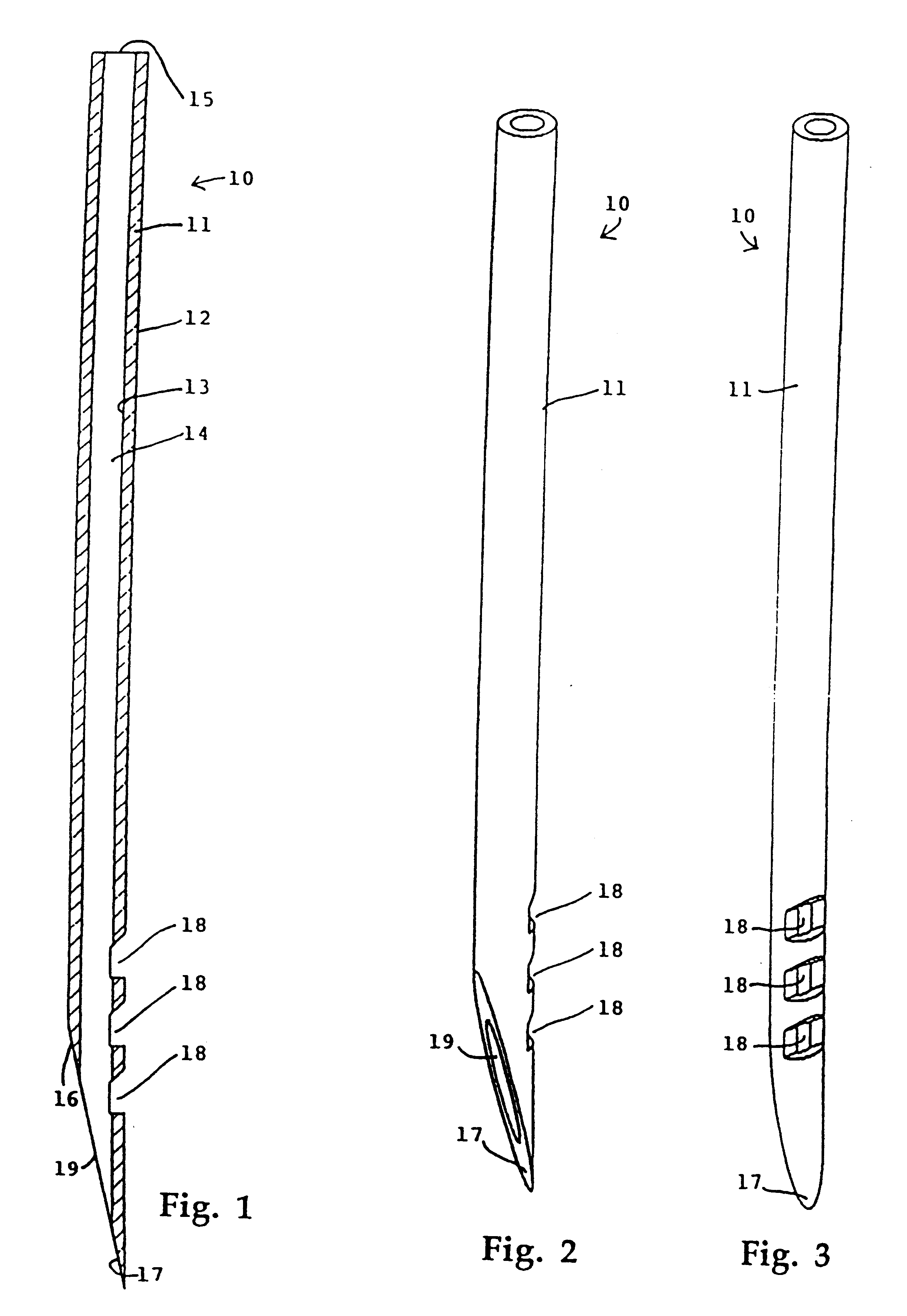Needle and method for delivery of fluids
a technology of fluids and needles, applied in the direction of injection needles, intravenous devices, automatic syringes, etc., can solve the problems of unreliable needle types, inability to ensure accurate delivery rates, and inability to provide satisfactory solutions for needles. achieve the effect of reducing costs
- Summary
- Abstract
- Description
- Claims
- Application Information
AI Technical Summary
Benefits of technology
Problems solved by technology
Method used
Image
Examples
second embodiment
Similar apertures can also be seen in FIG. 4, in which needle according to the invention, indicated generally at 20, is shown. Needle 20 is identical to needle 10 (FIGS. 1-3) apart from the shape of the sharpened end 21 and from the fact that the side of the needle is provided with five rather than three apertures 22.
In needle 20, the sharpened end 21 is closed, i.e. the internal bore 23 is only open at the top 24 of the needle 20 and at the apertures 22. The number of apertures can be chosen to suit the delivery rate which is required and the site into which the shaft 25 is to be inserted. A needle inserted into an area of tissue which is rich in capillaries or into a vein will not require as many apertures as a needle inserted into a site which is deficient in blood vessels or a site at which the number of blood vessels varies over small distances.
FIG. 5 illustrates the shape of the apertures 18,22 in the needles 10,20 of FIGS. 1-3 and 4 by showing the shape of the material 30 whi...
third embodiment
In FIG. 11, there is indicated, generally at 60, needle according to the invention. In this embodiment, apertures 61 are formed by machining a row of cuts across the needle at an angle equal to the bevelled angle of the tip 62. Dotted lines 63 indicate the parallel paths of the cutter which creates the bevelled tip 62 and the apertures 61.
Referring additionally to FIG. 12, it can be seen that a plurality of needles 60 can be aligned adjacent to and parallel with one another but laterally displaced, and the ends 64 of the needles 60 can be bevelled by cutting the needles along this row (the path of the cutter again being indicated by dotted line 63. The apertures 61 (FIG. 11) can then be cut along a parallel path while the needles 60 are aligned as shown.
In FIG. 13, there is indicated, generally at 70, a liquid delivery device according to the invention, which is suitable for use as an automated drug delivery device. The device 70 comprises a housing 71 containing a reservoir 72 whic...
PUM
 Login to View More
Login to View More Abstract
Description
Claims
Application Information
 Login to View More
Login to View More - R&D
- Intellectual Property
- Life Sciences
- Materials
- Tech Scout
- Unparalleled Data Quality
- Higher Quality Content
- 60% Fewer Hallucinations
Browse by: Latest US Patents, China's latest patents, Technical Efficacy Thesaurus, Application Domain, Technology Topic, Popular Technical Reports.
© 2025 PatSnap. All rights reserved.Legal|Privacy policy|Modern Slavery Act Transparency Statement|Sitemap|About US| Contact US: help@patsnap.com



